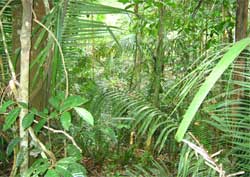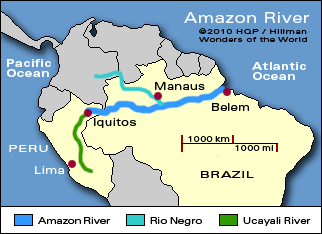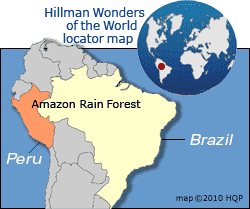Amazon Rainforest
 Why the
Amazon Rainforest
is special
Why the
Amazon Rainforest
is specialThe Amazon Rainforest is immense (it's larger than Europe). The 6280 kilometer (3900 mile) long Amazon River is fed by a thousand rivers - some over 1600 kilometers (1000 miles) long.
Amazon Rainforest tips and insights
Geography
Broadly defined, the Amazon Rainforest extends into nine South American countries. Nearly two-thirds are in Brazil. Peru is the runner-up.
Getting there
The Amazon's two major gateway airports are in Manaus (Brazil) and Iquitos (Peru).
Getting around
On my first trip to the Amazon, I quickly discovered that road trips are severely limited because the jungle is thick and dissected by numerous snaking rivers. Watercraft and occasionally small airplanes are the most effective means of transportation.
Cruising down the Amazon
The view from the deck of a passenger ship becomes monotonous. You get a bored dèjá vu feeling as the river and its banks remain virtually unchanged for days on end. And, the dense riverside greenery hides nearly all the wildlife you came to see.
The better Amazon cruises explore the Amazon tributaries and offer interesting land excursions.
Amazon rainforest lodges
An alternative to cruising is staying in one of the lodges along the small Amazon tributary streams. They range in quality from budget to luxury. Use the lodge as base to explore nature up close along jungle trails and narrow waterways.
Vital to life
The Amazon Rainforest produces 20% of the earth's oxygen (and is the source of 20% of our planet's fresh water).
Medicine
A large number of medicines we take for granted come from Amazon plants. And, because so many of the plant species have not yet been analyzed, we should see new drug discoveries.
Amazon Rainforest survival
About 14% of the world's land was once rainforest. Today it is down to 6%. Greenpeace, an environmental organization, warns that if deforestation continues at the present clip, the Amazon Rainforest will be history in 80 years. Some scientists predict an even earlier demise.
Biologically rich environment
More than a million colorful plant, animal and insect species inhabit the Amazon Rainforest.
Amazon Rainforest flora and fauna
Although the Amazon Rainforest looks like other rainforests to the amateur eye, nearly all its plants and animals are unique.
Nutrient recycling
The Amazon ground must be nutrient rich because it fosters profuse plant growth. Right? Wrong. The soil is nutrient poor. The rain forest survives because it quickly recycles its limited nutrient sources.
Water recycling
The Amazon also rapidly recycles its water. When it rains, the trees absorb the water, then let it evaporate, which creates clouds, which generate rain. Half that rain falls on the rain forest. The water shortcoming is made up by westbound clouds from the Atlantic Ocean.
Rainfall
Average annual rainfall approaches 3 meters (10 feet). Some areas can experience twice that amount.
The canopy
High trees create what is called the canopy, a dense umbrella of leaves. Little reaches the ground plants. To survive, they have developed broad leaves to capture as many diffused sun rays as possible.
Amazon cruise tips & insights
Manaus vs Iquitos - which is better?
They are the top two tourism gateway cities in the Amazon. Manaus is in Brazil, Iquitos is far upstream in Peru (see map above).
I've been to both. Iquitos easily wins. The Amazon river there is substantially narrower - and the tributaries are more remote, eco-diverse, and interesting. But this is not to say that the Manaus area isn't captivating. It is.
Iquitos
A few basics
- Iquitos has no external roads. You get there from Manaus by river boat (1400 kilometers or 800 miles) or from Lima, Peru by plane (2 hours).
- The town itself is of little interest to travelers. The highlight is a cruise to the Pacaya Samiria National Reserve.
- The average local Amazon cruise boat is appreciably smaller than its counterpart in Manaus. Typically they accommodate only a dozen or so passengers.
- And the eco-lodges around Iquitos tend to be more intimate.
A few basics
- Manaus is the most popular gateway for Amazon visitors. Most fly in or sail 1,700 kilometers (1,050 miles) up the Amazon from the Atlantic coast on river ferries or ocean-going cruise ships.
- Contrary to popular opinion, Manaus is not on the Amazon River. It's on the Rio Negro.
- There's scant visitor appeal in Manaus, except for a 19th century opera house.
- Manaus' glory? You can take river cruises here to the nearby Amazon River and various tributaries. You can also book stays at remote eco-lodges.
Mid-May to mid-November is the dry and best season. It can rain heavily during the rest of the year. Downpours make jungle excursion walks mud-messy.
Untold truths
- Don't raise your expectations too high about seeing a wealth of jungle animals. To survive, they hide in the thick rainforest growth. They see you, but not the other way around.
- An Amazon cruise is not for everyone. The equatorial sun scorches, the high humidity zaps energy, and a billion insects are pesty. But if you are an adventure, nature-loving traveler, the Amazon will amaze and thrill you.
Ecuador has eco-lodges on the Rio Napo, an Amazon River tributary. But there is no worth-mentioning cruise presence.
More insights
- Local Amazon cruises typically last 3 to 7 days.
- Shore excursions consist of both jungle boat rides up small tributary rivers and streams in motorized Zodiacs, skiffs, and canoes.
- You also go on educational jungle walks and visit small native villages.
Map




